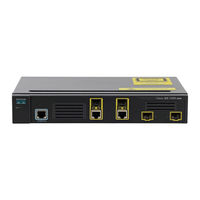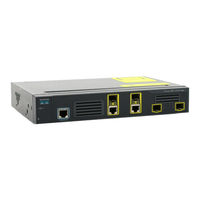Cisco ME-3400-24TS-A Manuals
Manuals and User Guides for Cisco ME-3400-24TS-A. We have 2 Cisco ME-3400-24TS-A manuals available for free PDF download: Software Configuration Manual, Datasheet
Cisco ME-3400-24TS-A Software Configuration Manual (885 pages)
Ethernet Access Switch
Brand: Cisco
|
Category: Network Router
|
Size: 9.82 MB
Table of Contents
-
-
-
-
-
Configuring NTP101
-
Table
113 -
-
-
-
-
RADIUS Operation148
-
-
-
-
Device Roles173
-
-
-
Figure178
-
-
-
-
-
-
Port-Based Vlans193
-
Switch Ports193
-
Access Ports194
-
Routed Ports195
-
Trunk Ports195
-
Tunnel Ports195
-
-
-
-
-
Supported Vlans224
-
UNI Vlans226
-
-
-
-
Table
235-
Displaying Vlans235
-
Configuring VMPS244
-
-
-
-
-
Configuring STP286
-
-
STP Overview287
-
-
Blocking State291
-
Listening State291
-
Learning State291
-
Forwarding State292
-
Disabled State292
-
-
-
-
-
-
-
-
-
Section on Page368
-
-
-
IGMP Versions379
-
Immediate Leave382
-
-
Configuring MVR395
-
-
-
-
Configuring UDLD433
-
-
-
Local SPAN437
-
Remote SPAN437
-
-
SPAN Sessions438
-
Source Ports440
-
Source Vlans441
-
VLAN Filtering441
-
Destination Port442
-
Rspan Vlan443
-
-
-
-
-
-
Configuring SNMP
481-
SNMP Examples490
-
-
-
Supported Acls493
-
Port Acls494
-
Router Acls495
-
VLAN Maps496
-
-
-
-
-
Numbered Acls514
-
Extended Acls514
-
Named Acls514
-
ACL Logging516
-
-
-
-
-
Modular Qos CLI540
-
-
Classification542
-
Table Maps548
-
-
Policing
549 -
Marking
553-
Configuring Qos563
-
-
Qos Statistics592
-
-
-
-
-
-
-
-
Types of Routing625
-
-
-
Configuring RIP641
-
Configuring OSPF646
-
Configuring BGP661
-
-
-
-
-
Multiple HSRP710
-
-
Configuring HSRP711
-
-
-
-
-
IGMP Version 1722
-
-
-
IGMP Version 2722
-
PIM Versions722
-
Auto-RP723
-
PIM Modes723
-
Bootstrap Router724
-
-
-
-
-
Advertisement

